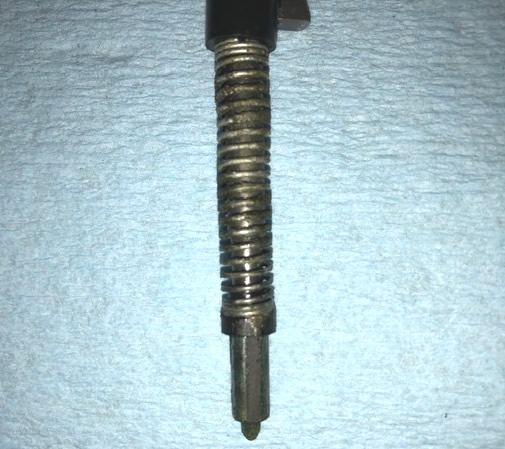Glock's pretty renowned for flawless operation under all kinds of conditions. They just run and run and run, with what is comparatively little attention.
When I worked at my former sheriff's office where I was lead firearms instructor, we had transitioned from a policy of "personally owned departmentally approved" duty firearms to issuing the .357 SIG chambered Glock 31. As the years went by, I really don't recall any failures to function with those Glock's-I know I never had one, and I was on our department SWAT team, so I got in more range time that the average deputy did.
With the Glock 31, I never felt the need to strip and clean it after each firing session-which was usually limited to about 50 rounds. This was due in part to the fact that we weren't shooting plain lead bullets for practice shooting like we did back in the revolver days. Fifty rounds of pure lead bullets using the powders we had back then got our revolvers dirty in short order.I did strip and clean my Glock on a fairly regular basis however. I happened to see the guns of deputies when they came in to the range as I did an armorer's check on them. Some of the deputies did not clean their guns after shooting, well, ever. That was verified by confession. However, those guns still shot and ran just fine when they shot them on the various courses of fire. And yes, I did get after them about cleaning.
Our police academy had Glock 19's that had hundreds of rounds shot through them during our summer training quarters sometimes with very limited cleaning. They all functioned flawlessly (until magazines wore out) and were never stopped by powder fouling.
The dirtiest Glock I ever saw-a .45 ACP Glock 21-had been shot repeatedly over a period of 6 years or longer, and never cleaned. It belonged to a police officer who was near retirement. It was the filthiest Glock I had ever seen-but unbelievably it still shot fine and functioned without fail.
Glock's really don't require much in the way of cleaning and lubrication compared to older handgun designs, especially those with stainless steel slides and frames. In fact, if you haven't read your Glock Owner's Manual, like I suspect many users haven't-especially the guys-you might not know that any Glock only requires a total of 5-6 small drops of oil for lubrication on very specific points. It is a pistol that you shouldn't over oil.
The one place that you should NEVER lubricate is the firing pin and firing pin channel. No oil! The firing pin and channel must be kept clean and dry, otherwise it will attract dirt and debris. Oiling that firing pin channel is the easiest way you can stop a Glock from functioning-but I never saw it happen until this week.
A fellow firearms instructor from another agency contacted me about a Glock that had multiple failures to fire during his department's qualification course. His officer was shooting a .40 caliber Glock 22. The firing pin was hitting the primer hard enough to leave an indentation on the primer, but not hard enough to cause every cartridge to fire. The ammunition being used was the excellent Speer Lawman FMJ practice ammo. Out of 50 rounds fired, there were approximately 10 failures to fire.
Operational technique on the part of the officer had been ruled out. The officer in question claimed that he had cleaned his Glock after the qualification course last year, so initially a dirty gun was not the primary suspect in the malfunctions. After all, the Glock is not hard to strip or clean. It breaks down into exactly four main parts-frame, slide, recoil spring/guide and barrel.
My buddy is also a Glock armorer. He didn't have time during qualification to strip down the gun because he had other officers to qualify. He advised this officer to carry his Glock 23 instead of the 22 as it seemed to be functioning ok. He told his officer to bring in the Glock 22 (and later this officer's Glock 23 and 27) the next week for him to inspect-which is what generated his call to me.
The insides of the officers Glock 22 were gunked up with, well, neither one of us could be sure what the greenish material found throughout the innards of his 22-and 23 and 27-were. The stuff even clogged up the recoil spring assembly and the extractor mechanism!
My buddy did a full armorers strip of the Glock 22 first. He noted how sluggishly the slide cycled by hand. When he got to the firing pin assembly-which normally falls out easily after the backing plate at the rear of the slide is removed-had to be pulled clear with pliers! He had never seen anything like this before-and he has armorer stripped a lot of Glock's over the years.
The firing pin assembly and springs were all coated with this greenish gunk! When questioned as to what he cleaned and lubricated the gun with he replied "Hoppe's #9". Oops. It took a while not only to clean the stuff off of the firing pin, but also the firing pin channel.
Hoppe's number #9 is the all-time great gun cleaner. It's vaguely cherry odor still brings back fond memories of shooting .22's with my dad as a kid and cleaning our guns afterwards-as it does for many older shooters out there. It is great stuff for removing powder fouling. But it isn't a lubricant.
I suspect the now embarrassed officer sloshed Hoppe's #9 all throughout his Glock's and then didn't wipe the Glock dry and lubricate it with proper gun oil as directed. He merely left the Hoppe's #9 it in place, which I suspect caused the green colored fouling to develop over time. He had obviously used this so heavily (he may have dunked the gun in it) that it was it found its way into the firing pin channel and caused it to clog up.
Let me reiterate this point. Hoppe's #9 is a great gun cleaner-when used properly as directed like any other product-but it is NOT a lubricant. If you are using it now on your Glock's or other handguns don't stop because of what I am writing here. My police academy used Hoppe's #9 to clean our Glock 19's for 27 years and never had a problem because we used it according to directions. Since Hoppe's #9 is a single purpose product, Hoppe's gun oil was used for lubrication after all the Hoppes #9 was wiped out and all metal surfaces were dry. No lubrication or Hoppe's #9 was ever put in the firing pin channel at our Academy.
Pouring lubricant or powder solvent into the firing pin channel and leaving it there is the one easy step it takes to stop a Glock. If you are new to guns and cleaning, you can select a product like Break Free CLP (Clean Lubricate and Protect) which does everything that you need and simplifies the cleaning chore. Our military has used Break Free successfully for many years to clean, lubricate, and protect the dirtiest shooting military arm on the planet-the M16. I know they dunk M16 parts in it, which is where our officer in question, who is a Desert Storm veteran, many have learned the technique. What's good for M16's isn't necessarily good for all guns.
In the end my buddy did armorer's strips and cleaning on all three Glock's, and got them back in operational condition in short order. The 23 and 27 weren't in quite as bad shape as the 22. The officer in question remarked how smoothly the slides functioned manually now, so he can hit the streets again with a Glock that will go "boom" when it is needed rather than "click".
So, it is possible to stop a Glock, although in the end, the Glock 22 in question fired far more rounds than it failed to fire. Technically it was still operational-just not to the extent that any one of us would want to trust our life to it-be it cop or civilian.
The officer in question has been trained in proper Glock cleaning procedures so this shouldn't happen again. If you have a Glock, and you haven't cleaned and stripped it per manufacturer's directions with the proper cleaning supplies, it is time to get the owner's manual out and get to it. If you just do some minimal maintenance your Glock will run and run and run without fail.



